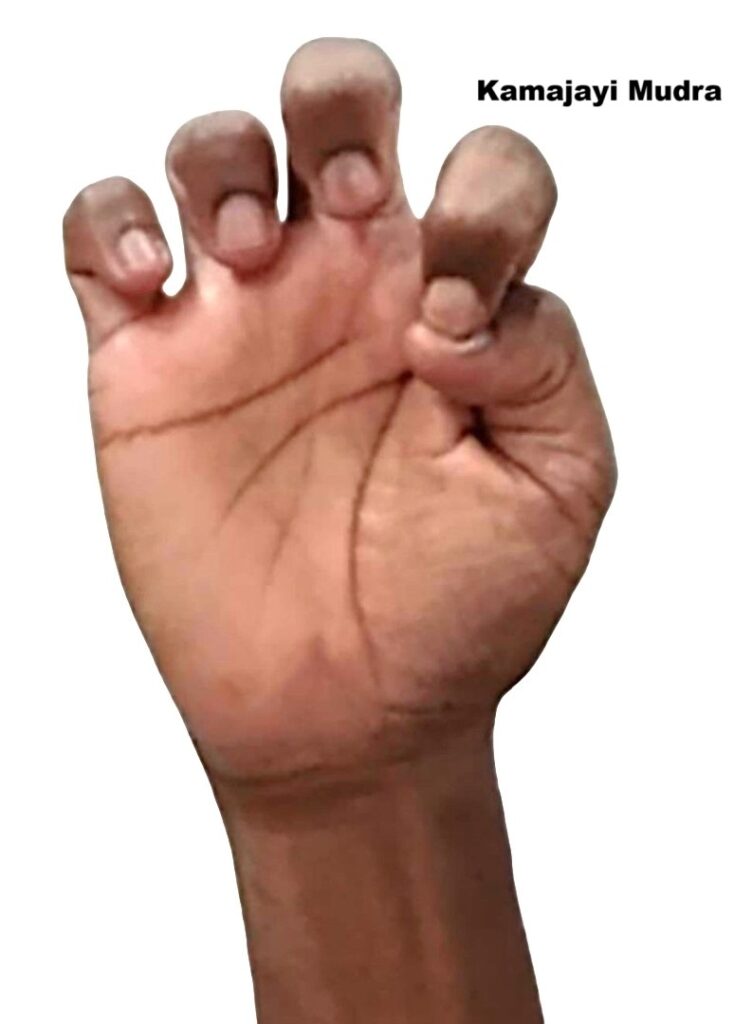Kamajayi Mudra
Introduction
Kamajayi Mudra is a powerful yogic hand gesture described in Hatha Yoga texts for mastery over desires and senses. The term itself indicates the victory (jaya) over kama (desires, passions, sensual urges). It is considered both a mudra and a tantric practice, often used to channel sexual energy into higher spiritual energy, supporting brahmacharya (self-restraint) and deeper meditation.
This mudra is especially recommended for practitioners who want to stabilize the mind, conserve energy, and direct prana (life force) inward.
Meaning
Kama = desire, passion, sensual energy.
Jayi (from jaya) = victory, mastery, control.
Mudra = seal, gesture, or psychic attitude.
Kamajayi Mudra therefore means “the gesture of conquering desire”.
How to Perform (Method of Practice)
Step-by-Step Instructions:
Sit in a comfortable meditative posture like Padmasana (Lotus Pose), Sukhasana (Easy Pose), or Vajrasana (Thunderbolt Pose) with the spine erect.
You can practice this mudra in any position with either or both hands. Press down on the root of your thumb nail with the tip of the index finger of the same hand.
Allow the other fingers to remain relaxed and slightly curled.
Keep the hands just below the navel region (Swadhisthana/Manipura chakra area).
Close your eyes and focus on your breath and awareness of lower abdomen.
Maintain deep, slow, rhythmic breathing.
Mentally repeat an affirmation or mantra, such as “I master my desires” or chant Om Shanti for inner peace.
Benefits
Physical Benefits:
Supports better hormonal regulation by calming the pelvic region.
Improves digestion and pranic flow in the abdominal area.
Enhances stamina by conserving energy.
Mental & Emotional Benefits:
Helps overcome lust, addictions, compulsive behaviors.
Enhances willpower, clarity, and determination.
Provides emotional balance, especially during stress or temptations.
Spiritual Benefits:
Supports brahmacharya (continence, self-control).
Assists in sublimating lower desires into spiritual awakening.
Helps stabilize prana in Swadhisthana and Manipura chakras, preparing for higher meditation.
Contraindications
Should not be practiced during intense emotional disturbances unless guided by a teacher.
Those with severe depression or suppressed desires may experience discomfort—gradual practice advised.
Pregnant women should avoid holding mudra for long periods.
Avoid after heavy meals.
Anatomy & Physiology
Hands & Fingers: Both hands are relaxed, forming an energy seal.
Nervous System: The mudra calms the autonomic nervous system by reducing overactivation of sympathetic arousal linked to desires.Endocrine: May influence gonadal and adrenal glands, reducing overstimulation.
Respiratory: Encourages slower and deeper breathing.
Kinesiology
Minimal musculoskeletal effort.
Gentle hand positioning promotes relaxation in shoulders, arms, and pelvic floor muscles.
Reinforces stillness by reducing unnecessary micro-movements of the hands.
Neurology
Activates parasympathetic response, calming sexual and emotional urges.
Strengthens prefrontal cortex activity, enhancing willpower and decision-making.
Helps in reducing limbic system overdrive, balancing emotions and desires.
Duration of Practice
Beginners: 5–10 minutes daily during meditation or pranayama.
Intermediate: 15–20 minutes, especially useful in morning/evening practice.
Advanced: Up to 30 minutes or integrated throughout meditation sessions.
Best practiced at dawn, before meals, or before bedtime for calming desires.
Counter Mudra
Apana Mudra – to balance elimination and grounding.
Dhyana Mudra – to restore calm neutrality after intense practice.
Conclusion
Kamajayi Mudra is a sacred yogic hand gesture designed to help practitioners control passions, transform desires, and achieve mastery over the senses. It has profound effects on the mind, emotions, and spiritual energy, making it a valuable tool for anyone seeking inner discipline, emotional stability, and higher awareness. By sublimating lower urges, the practitioner gains more focus and freedom for spiritual growth.
FAQ
Q1: Can beginners practice Kamajayi Mudra?
Yes, it is simple and safe for beginners with mindful practice.
Q2: How long does it take to see results?
With daily practice, improvements in self-control and calmness can be noticed within a few weeks.
Q3: Can it be practiced during stress or temptation?
Yes, it is especially beneficial at such times to redirect energy inward.
Q4: Is it only for celibate practitioners?
No, it is useful for anyone who wishes to balance desires and strengthen willpower.
Q5: Can it be practiced while standing or walking?
No, it is best practiced in a seated meditative position with stillness.
References
Swami Satyananda Saraswati – Asana, Pranayama, Mudra, Bandha.
Gertrud Hirschi – Mudras: Yoga in Your Hands.
Swami Niranjanananda Saraswati – Yoga Darshan.
B.K.S. Iyengar – Light on Yoga.
Research articles on mudra therapy, meditation, and neuropsychology of desire regulation.
